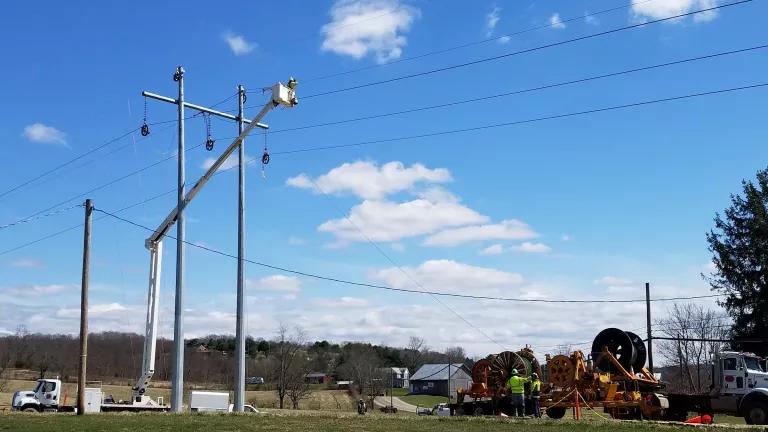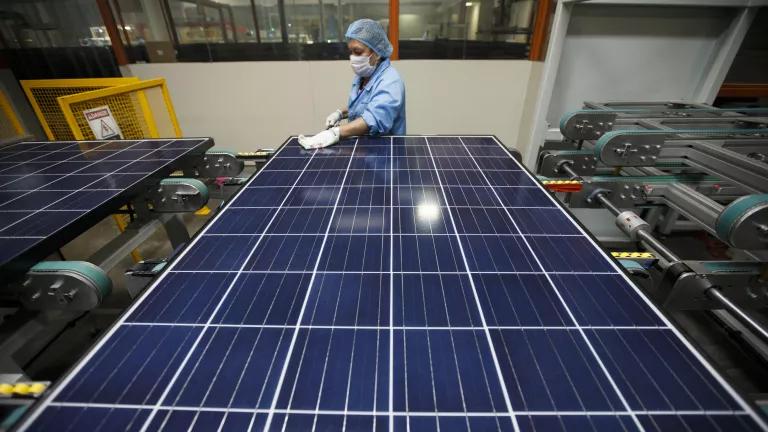“Innovate, manufacture, compete. That’s everything we want to do.”
Spoken by David Danielson, assistant secretary for energy efficiency and renewable energy at the U.S. Department of Energy (DOE) at the Pew Charitable Trust’s Clean Energy Action Plan meeting, the words rang true for the audience of business leaders, innovators, manufacturers, and policy experts. Inventing and making clean energy technologies within our borders are imperatives in strengthening America’s clean energy sector. But to make this happen—a point reflected in the conference’s twitter hashtag—#policymatters.
“Government has a critical role to play in launching new, innovative industries,” Danielson said. Indeed, from investing in research to develop new technologies, to securing policy certainty at the federal and state levels, to helping commercialize the best energy innovations, government has been, and will continue to play, an important role in developing the nation’s clean economy, and the 3.1 million jobs that it supports.
Innovate
Federally-funded national laboratories like the National Renewable Energy Laboratory (NREL), Argonne National Laboratory, Lawrence Berkeley Laboratory, and others, conduct research critical to make the technological progress needed to continue to drive down the cost of clean energy.
“The first step is to provide sufficient, consistent, and long-term support to long-term innovation in the energy sector,” said NREL’s Dana Christensen. “This will ensure that the cost of renewable energy and energy efficiency technologies will continue to come down and become more competitive in the marketplace.”
One important program the government has championed is its SunShot Initiative, a collaboration between academia, private companies, and national laboratories to decrease the cost of solar power 75 percent between 2010 and 2020. This will allow the renewable resource to become cost-competitive enough with grid power to generate between 15 and 18 percent of America’s total electricity by 2030. Over the past four years, the hardware costs of solar technologies themselves have already fallen about 75 percent. SunShot’s focus on reducing the soft costs—like installation and sales—is critical in achieving the remaining cost reductions.
Beyond the SunShot Initiative, clean energy projects spurred by public investment include building efficiency, as well as the DOE’s energy innovation hubs, which tackle science and technology issues to achieve breakthroughs in energy technologies for energy efficiency, energy storage, materials, and converting sunlight into fuels through artificial photosynthesis.
Manufacture
Another imperative for policy stability is manufacturing, and the jobs that come with making things within American borders.
“How do I create jobs? Good jobs that create a middle class?” asked Jeff Metts of Astraeus Wind, a wind technology developer and manufacturer in Eaton Rapids, Michigan, struggling to deploy technologies in the face of uncertain energy and economic policies.
In 2007, Metts built a new facility as part of Dowding Industries, the parent company to Astraeus, to make wind turbine hubs and blades “better, faster, and cheaper.” While the technology stands to significantly lower the cost of wind-powered electricity, and employ a significant workforce in Eaton Rapids, Michigan—a community hard hit by the recession—securing funding to demonstrate the technology and get the business off the ground has been the hardest part in building a new business.
The Production Tax Credit (PTC)’s scheduled December expiration, and Congress’s inaction on its renewal, does not help. The uncertainty of the tax credit, which pays wind developers 2.2 cents for every kWh of wind energy produced, is causing rifts throughout the wind industry, delaying projects and putting 75,000 jobs at stake. While the policy still may be renewed after November, Congress failing to act on it has already resulted in losses. “We’ve been laying off people since March,” said Metts. “We need [policy] stability to launch technologies.”
Compete
With the average 250 MW wind farm supporting 1,079 jobs, policy stability, and PTC extension, should be a congressional priority to retaining, and creating, American jobs. Beyond, it can increase the U.S.’s international competitiveness. “We can make the same turbine hub in 24 hours for 20 percent cheaper [than international competitors],”said Metts.
But the deployment of that technology is at stake without policy certainty. For Metts to build his company, and for America to fully capture its opportunity to innovate, manufacture, and compete in the global clean energy economy, #policymatters. Investors, entrepreneurs, manufacturers, developers, job creators, policy experts all recognize the need for stability and policy certainty. Congress should too.




